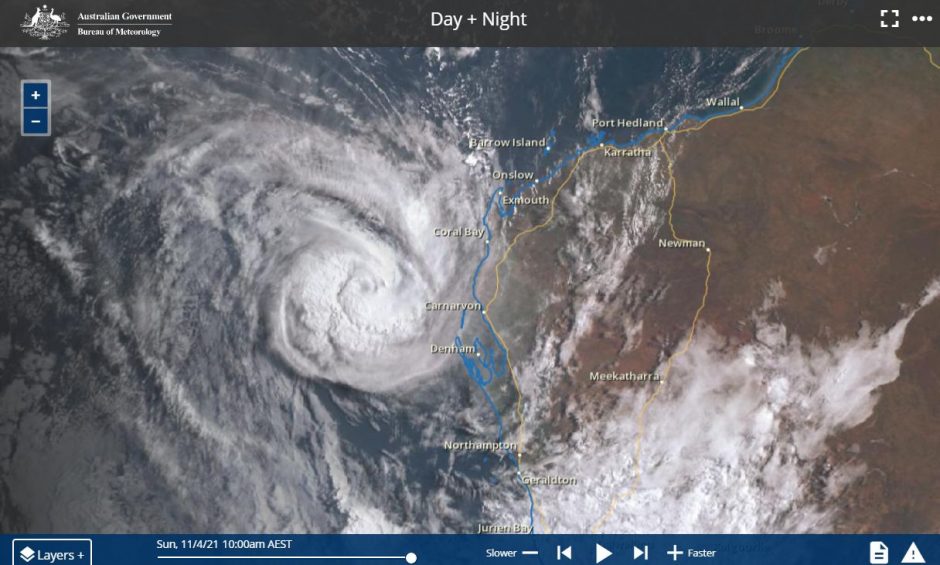Tropical Cyclone Seroja has made landfall very close to the town of Kalbarri in Western Australia and has caused some significant damage to the town. In addition, the regional city of Geraldton was also impacted by gale force and damaging winds including a period of heavy rain as the storm passed over.


The storm was travelling unusually fast at landfall and reached a speed of at least 55 km/h. It had a relatively narrow track as it traversed over land towards the south east.
Media reports have indicated that peak wind gusts reached 170 km/h and that the storm was a Category 3 system upon landfall.
While verified data is still being processed and updated, a number of weather stations within proximity of the storm have recorded the following peak wind gusts:-
Geraldton Airport - 120 km/h at 8.52 pm and 8.57 pm. However, not recorded in the detailed notes, a single peak gust of 121 km/h was recorded at 9 pm according to data taken from “Australian Weather News”.
Furthermore, significant peak wind gusts at Geraldton Airport occurred mainly between 8.23 pm and 9.08 pm on Sunday evening.
Morawa Airport - A single peak wind gust of 119 km/h occurred at 11.26 pm.
Shark Bay - Maximum peak wind gusts of 91 km/h occurred.
According to observations taken from the following sites (Taken from “The Australian Weather News” 12/4/2021)
Binnu Agricultural Station - A peak wind gust of 122 km/h occurred at 8.04 pm.
Morawa Agricultural Station - A peak wind gust of 132 km/h occurred at 11.21 pm.
At the present time, additional verified data is not available and the above represents the highest identified wind gusts known as at 8 pm 12/4/2021 (Sydney Time - New South Wales).
Tropical Cyclones across the world are categorized according to their location. For example, across the Atlantic Ocean, Eastern and Central Pacific, the Saffir Simpson Scale is used and CIMSS models use the scale. Generally the National Weather Service (USA) uses the scale to determine the strength of a tropical storm.
Tropical Cyclone Seroja was determined to peak as a Category 1 system at landfall on the CIMSS models. A Category 1 storm has sustained peak wind gusts of between 119 km/h and 153 km/h and based on available data, this storm would fit the Category 1 storm system. If verified peak gusts of 170 km/h did occur, then it is possible that the storm reached Category 2 on the Saffir Simpson Scale.
Note - A Category 2 storm has maximum sustained peak wind gusts of between 154 km/h and 177 km/h on the Saffir Simpson Scale.
The Bureau of Meteorology uses a different scale for measuring the strength of tropical cyclones which makes a comparison somewhat confusing. The scale is called the “Australian Tropical Cyclone Intensity Scale” which was introduced in 1989/1990 and under this scale:-
A Category 1 storm has sustained winds of 63 to 88 km/h and with peak wind gusts of 91 to 125 km/h.
A Category 2 storm has sustained winds of 89-117 km/h with peak wind gusts of between 126 km/h and 166 km/h.
A Category 3 storm has sustained winds of 118-157 km/h with peak wind gusts of between 167 km/h and 225 km/h.
A Category 4 storm has sustained winds of 158-198 km/h with peak wind gusts of between 226 km/h and 280 km/h.
A Category 5 storm has sustained winds exceeding 198 km/h with peak wind gusts greater than 280 km/h.
Hence on the Saffir Simpson Scale, this storm appears to have rated Category 1, possibly Category 2 but under the “Australian Tropical Cyclone Intensity Scale”, the storm would have fit as a Category 3 system.
The Australian system for determining the strength of a tropical cyclone has lower thresholds than that of the Saffir Simpson Scale.
Hence, depending on what scale is used, the strength of Tropical Cyclone Seroja will vary and can be confusing.
The storm has all but decayed and for the 24 hours till 9 am 12/4/2021, a narrow band of rain of between 50 mm and 74 mm occurred along its path. The highest verified rainfall along its path for the is 24 hours is 76 mm at Binnu West.
Source
1 - Australian Weather News 12/4/2021.
2 - Bureau of Meteorology 12/4/2021 - Australian Tropical Cyclone Intensity Scale 1989/1990.
3 - National Weather Service - Saffir Simpson Hurricane Scale.
Addendum to topic - Peak wind gusts
Further to the above topic, further data has been identified in which a peak wind gust of 139 km/h occurred at Binnu West at 9.47 pm Sunday and the Bureau of Meteorology has identified a peak wind gust to 170 km/h at Meanarra Tower near Kalbarri at 7.03 pm on Sunday. They appear to be the higher wind gusts not appearing in the day to day data sets from surrounding weather stations.
